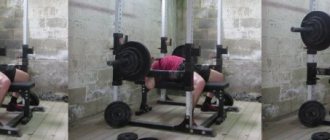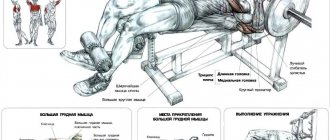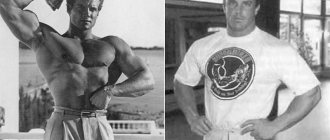If you want to know how to do and increase the bench press, this article will tell you everything you need to know about it.
“How much do you bench?”
If you have been training for a certain period of time, then you have probably been asked this question often. And you know without further clarification that they are asking about the results in the bench press.
Like it or not, nothing turns people's heads quite like lifting an impressive amount of weight on the bench press. And it seems that nothing frustrates beginners more than poor results in this exercise.
There's a reason why every well-designed training program includes the bench press as one of its main exercises. The importance of this exercise cannot be overestimated.
The fact is that the bench press is one of the best upper body exercises that develops the pectoral and latissimus muscles, shoulders, triceps and even to some extent the leg muscles.
If you are reading this article, then perhaps none of this is news to you. You are here because you want to improve your bench press performance and I can help you with that.
The first thing you need to know, although it may sound simple enough, the bench press is an exercise that requires some technique. If you don’t know what and how you are doing, then sooner or later you will stop making progress, unless, of course, you manage to avoid injury before then.
In this article, we'll talk about everything you need to know about the bench press to improve your bench press performance and get the most out of this exercise.
Video on how to bench press the most.
Let's start by discussing technique.
- Proper Bench Press Technique What Equipment is Suitable for the Bench Press? First, if possible, avoid using a Smith machine.
- Power frame is the best choice
- Bench and bar also matter
- Dumbbell Bench Press
- Correct psychological attitude
- Rest 3-4 minutes between sets.
Correct bench press technique
The bench press looks like a simple enough exercise, but how do you do the bench press correctly?
You lie on a bench with your feet flat on the floor, remove the bar from the racks, lower it to the center of your chest, and then press up.
This exercise can be performed in many ways, but, unfortunately, in most cases it is performed incorrectly.
Therefore, in order to analyze this exercise in detail, let's start with the equipment.
What Equipment is Suitable for the Bench Press?
Proper equipment has a significant impact on effective bench press performance.
First, if possible, avoid using a Smith machine.
The main disadvantage of the Smith machine is that it provides less muscle mass and strength gains compared to free weights.
One of the main reasons for this drawback is that the bar moves exclusively along a vertical fixed path. On the other hand, the free weight must be stabilized to prevent it from deviating from the correct trajectory.
When I used to bench press on the Smith machine, I never lifted more than 110kg for multiple reps. But when I first switched to free weights, I had a hard time lifting 80 kg.
This was a few years ago, and since then I have been benching up to 130 kg for 2-3 reps. The result is not outstanding, but quite decent.
Power frame is the best choice
A regular power rack will be an excellent choice, provided that you train with a spotter, because if you train without one, you will probably not be able to lift your maximum weight for fear of dropping the bar on yourself.
Even if you are an experienced athlete and know your strength well, when training to muscle failure there may be a situation where you feel like you can do one more repetition but fail.
Train in a power rack. Here is a classic example of a bench press power rack.
What makes this machine safe is the barbell lift control system. Set the limit bars to the desired height and they will prevent the apparatus from falling onto your chest when you fail a rep.
Here's how to do it:
Bench and bar also matter
Since we're on the subject of equipment, let's talk about the bench and bar.
You need to make sure that the bench is large enough to support your upper back and remain stable during the exercise. A bench 30 cm wide will do just fine.
Once again, I recommend the classic format bench:
If you are training at home, I recommend purchasing a high quality bar with arms that can rotate independently of the bar shaft. This way, the weight plates can rotate without rotating the bar, which would put more strain on the wrists.
Correct body position when bench pressing
With the equipment ready, it's time to talk about proper body positioning when performing the bench press. The first two steps are the following:
- Lie down on the bench so that your eyes are under the bar.
- Lift your chest, squeeze your shoulder blades together and press them into the bench.
You should feel tension in your upper back and you should maintain this position throughout the exercise.
- Grasp the bar with a grip slightly wider than shoulder width.
Hold the bar in your palms, closer to your wrists than your fingers, and squeeze it as tightly as you can.
The wrists should be straight and not bent towards the head. This will help prevent wrist pain.
A good way to check your grip width is to have someone stand behind you and look down at the position of your forearms at the bottom of the exercise.
Your forearms should be perpendicular to the floor. That is, like this:
As you can see, on the far left photo the position is too wide, on the middle one it is too narrow, and on the far right it is correct.
- Bend your lower back slightly and place your feet shoulder-width apart at right angles to your knees.
The back should not lie flat on the bench, and at the same time you should not bend it so much that the pelvis is almost under it.
Just maintain the natural curve that occurs when you arch your chest.
- With straight arms, lift the barbell from the racks and then move it in a horizontal line until it is directly above your shoulders.
Now you are ready to perform the bench press.
Do these movements every time you bench press, whether you're warming up or preparing to set a personal best.
This is good practice for developing proper technique, which will not only benefit the exercise, but also reduce the risk of injury.
How to lower weight correctly
The first thing you should know about arm movement when performing the bench press is the correct position of your elbows.
Many people make the mistake of spreading their elbows out to the sides, which can lead to shoulder injury. This mistake is the main reason why the bench press is considered a dangerous exercise for the shoulders.
A less common mistake is to place your elbows too close to your body, which robs you of stability and the ability to exert maximum force.
It is necessary that the elbows are located at an angle of 50-60° to the body. This will prevent the risk of injury and also provides a stable and secure position for performing the exercise. To better visualize this, look at the diagram:
If, at the lowest point of the exercise, the elbows are positioned at an angle of approximately 20º, then this is too close, and at an angle of 90º, it is too wide. The middle position at an angle of about 60° is optimal.
So now that you know the correct elbow position, let's get back to the exercise.
Keeping your elbows in the correct position, lower the bar to your lower chest near the nipples.
Yes, the bar should touch the chest! Forget about half reps!
You must control the movement of the bar as you lower it, but you should not lower it too slowly, because this will not have the best effect on muscle gain. Lower the bar for about 2 seconds.
How to properly remove the barbell and place it on the rack
Now that the bar has made contact with your chest (touched, not bounced off), you are ready to press the barbell up.
Although the name of the exercise suggests that you are supposed to “press” the barbell, it is better to imagine that you are pushing it.
That is, imagine that you are pushing your body away from the bar, and not vice versa. This will help you maintain proper technique and apply maximum effort.
The bar should make a slight arc, moving from the chest to the starting position in which it is easiest to balance.
Extend your elbows rather than keeping them slightly bent. This will prevent the risk of you dropping the weight.
When lifting the weight, the body maintains the above-described position: the shoulder blades remain pressed to the bench and brought together, the elbows are at the correct angle to the body, a slight arch in the lower back is maintained, the buttocks are on the bench, and the feet are on the floor.
How to properly place a barbell on a power rack
Do not try to place the barbell on the racks by squeezing the weight towards its stops, as you risk dropping the barbell on your face.
Always finish the rep first, and with the barbell over your shoulders and your arms extended, move it horizontally to the racks.
Let's summarize the above
To better imagine the whole process, watch the video. Here's what it all looks like in action:
Why might you need to increase your bench press?
The question, at first glance, is stupid. In fact, the goals you pursue when trying to increase your bench press determine not only how you can achieve this. It turns out that the very concept of “increasing your bench press” can mean completely different things to different people. I'll try to explain.
Typically, the exercise “bench press” is present in the arsenal of at least four sports disciplines. Strength sport - powerlifting. In it, increasing the bench press means increasing the weight on the barbell, which the athlete can press from the chest once. That is, here we are interested in the indicator of absolute strength. Volume-strength sports – bodybuilding and related disciplines. Here the athlete’s goal is to maximize muscle volume by combining strength loads. It is achieved by performing exercises for an average number of repetitions: usually from 6 to 12.
That is, increasing the bench press for a bodybuilder means increasing the working weight of the equipment with which the athlete performs the required number of repetitions. There are sports aimed at strength endurance . Such as the high-repetition bench press and its variations. The name itself already tells us that increasing the bench press for a high-repetitioner means increasing the number of times he can press a certain weight from his chest. And finally, speed-strength sports . This can conditionally include martial arts and various types of functional training. As the name of this group suggests, the barbell is generally used here as an auxiliary equipment. And any increase is, first of all, an increase in speed and dynamic strength.
So, in this article I would like to look at the first option I mentioned. Namely: how to increase your bench press when lifting the maximum weight for one repetition.
Types of bench press
The standard barbell bench press is a staple exercise in many strength training programs, but it is usually accompanied by several variations.
Let's look at the most common options.
Dumbbell Bench Press
Although this exercise is not a direct replacement for the bench press, the dumbbell press is still an exercise that deserves attention.
One of the main problems that athletes face when performing this exercise is maintaining heavy dumbbells in the correct position.
This is what it looks like:
In terms of training routine, I usually alternate dumbbell presses with barbell presses for my shoulder workouts.
For example, I do 3-4 sets of incline dumbbell presses, 3-4 sets of flat bench presses, 3-4 sets of weighted dips for 8 weeks. Then for 8 weeks I will do 3-4 sets of flat bench press, 3-4 sets of incline bench press and 3-4 sets of flat dumbbell press.
Close grip bench press
The narrower the grip, the more load is placed on the triceps.
This grip is not desirable if you are focusing on training the chest, but it is one of my favorite ways to train the triceps. And by the way, strong triceps guarantee good results in the standard bench press.
A close grip means that you should grip the bar slightly narrower than shoulder width.
You may see some lifters holding the bar with their arms just a few inches apart. This is a bad idea because this grip puts the wrists and shoulders in a very weak and risky position.
All other recommendations regarding the technique of performing the exercise remain the same: shoulder blades pressed firmly to the bench, a slight arch in the lower back, feet on the floor, the bar describes a small arc as it lowers, touches the lower chest, and then rises back.
If you feel discomfort in your wrists or shoulders at the bottom of the exercise, simply widen your grip by about a finger's width and continue the exercise.
If you still feel discomfort, increase your grip width again by a finger's width and repeat until you find a position that is comfortable for you.
Here's a good instructional video:
Incline Bench Press
The upper chest debate is one of the “controversial” aspects of bodybuilding.
Do I need to do chest exercises to work the upper part of the chest? Or do all the chest exercises to pump up every possible muscle fiber? And even more than that – is there such a thing as “upper chest”?
I'll try to explain briefly.
There is a part of the pectoral muscle that is what we call the “top of the chest.” It is located in the collarbone area and looks like this:
Although these muscles are part of the pectoralis major muscle, their fibers are quite different. Thus, some exercises can focus on the main muscles of the chest, while others on the clavicular part.
Notice that I said emphasis rather than isolation, because exercises that work the first or second part of the muscle will affect both parts to a certain extent.
However, proper development of the chest muscles requires working out the muscles of the upper part for two simple reasons:
- working out these small, stubborn muscles takes longer;
- The best exercises for these muscles are also great for developing the pectoralis major muscles.
The best way to ensure that the upper chest does not lag behind the rest of the pectoral muscles is to perform incline bench presses frequently.
The reverse grip press will also help you with this, and we'll talk about that soon.
That's why the incline press is such a big part of my Bigger, Leaner, Stronger and Leaner, Leaner, Stronger programs, and why I'll be recommending the same thing here.
When performing a bench press on an inclined bench, the angle of the bench should be 30-45°.
I prefer an angle of 30°, others like an angle of about 45°. I recommend that you try different angles in this range and find the one that works best for you.
All other recommendations regarding equipment and technique for performing the exercise remain the same as for performing a regular bench press, with a few exceptions:
- The bar should go past the chin and touch the body just below the collarbone. This will ensure the bar moves vertically.
Here is a video showing the correct execution of a barbell bench press on an incline bench:
And also with dumbbells:
Upside Down Incline Bench Press
The overhead bench press is a popular exercise among some athletes, but I am not one of them. Due to the reduced range of motion, this exercise is less effective than a regular or incline press.
The main argument given for this exercise is that it develops the lower part of the pectoralis major muscle, but I prefer to do dips for this exercise.
The bottom line is that you will never get great chest size if you only do bent over presses.
Reverse grip bench press
The reverse grip press has its advantages, which are often overlooked.
You should wrap your palms around the bar, which will not only reduce the stress on your shoulders, but will also work your upper chest more effectively.
Here's how to do it:
Calculator for calculating one repetition with maximum weight (1RM) in the bench press
The only 100% accurate way to know how much weight you can bench press for a certain number of reps is to simply do the exercise. But there are several formulas that can predict results with a fair amount of subtlety.
The most commonly used formulas are Brzycki, Bachley and dos Remedios.
Use the calculator to predict your 1RM.
Weight lifted: _____ ○ lbs. ○ kilograms.
Number of repetitions: ____
| 1RM | |||||||
| 95% 1RM | 90% 1RM | 85% 1RM | 80% 1RM | 75% 1RM | 70% 1RM | 65% 1RM | 60% 1RM |
| Estimated reps and weight based on 1RM | ||||||||||||
| Repetitions | 1 | 2 | 3 | 4 | 5 | 6 | 7 | 8 | 9 | 10 | 15 | 20 |
| Brzycki | ||||||||||||
| Bachley | ||||||||||||
| Dos Remedios | ||||||||||||
If you're wondering how to measure your performance, here's a handy guide.
The following figures are indicators that can reasonably be expected from people with various levels of training.
| 1RM Bench Press for Adult Men | |||||
| Body weight | Without preparation | Newbie | Average level | Advanced | Professional |
| 67 | 49 | 64 | 78 | 106 | 132 |
| 75 | 54 | 69 | 85 | 102 | 145 |
| 82 | 58 | 74 | 91 | 125 | 156 |
| 90 | 61 | 78 | 97 | 131 | 164 |
| 100 | 64 | 83 | 102 | 139 | 173 |
| 110 | 68 | 86 | 105 | 143 | 179 |
| 1RM Bench Press for Adult Women | |||||
| Body weight | Without preparation | Newbie | Average level | Advanced | Professional |
| 52 | 26 | 35 | 39 | 49 | 51 |
| 56 | 27 | 35 | 41 | 53 | 64 |
| 60 | 29 | 37 | 43 | 55 | 68 |
| 67 | 32 | 41 | 48 | 61 | 75 |
| 75 | 34 | 44 | 51 | 66 | 83 |
| 82 | 37 | 47 | 55 | 72 | 87 |
The “no preparation” column shows the expectation for those who have not bench pressed before.
The "average" column shows the standard strength level for those with several years of bench press experience.
The “professional” column contains indicators for competitive athletes (1% of athletes).
What will help you gain weight?
First of all, you should understand that when you train for strength, your task is to force the maximum number of muscle groups to work for results. When working on mass, you purposefully load a separate muscle group so that it grows as much as possible.
Golden rule number 1 – pump your whole body
In addition to bench presses, do other basic exercises. That is, be sure to pump the rest of your body, not just your chest. The coordinated work of a large array of muscles will help you lift more weight than just one muscle group.
It happens that squats cause discomfort in the lower back, but deadlifts go fine. Then you can replace squats with leg presses. This is also a good option that makes muscle mass grow.
Practice shows that it is impossible to achieve significant progress by doing just the bench press from workout to workout. The muscles get tired and stop responding to the load.
So when a bench press program goes beyond the bench press, the chest, triceps, and shoulders are given a rest while you train the other muscles. And this is very important.
Plus, heavy exercise (like a squat or leg press) spurs the production of testosterone, which will directly affect your strength.
Rule 2 - let your muscles rest
Overfatigue negatively affects training results. If you feel that you have not yet fully recovered from your previous session, it is better to reduce the intensity of the workout and give yourself time to rest.
Overworked muscles lose 10–15% of their strength. For example, if you bench press 100 kg for 3 reps, in a state of overtraining you will bench 85–90 for the same 3 reps.
It is believed that power benching should be done once a week. But you must focus on your body. Some people bench press not 2 times a week, but 3. Some – only 1 time. Each person has their own training regime.
Rule 3 – convenient schedule and good program
Choose the optimal training regimen for yourself. It should be in harmony with your lifestyle and daily routine. Competent trainers create training programs based on the characteristics of the client’s life rhythm.
Your bench press program should include a basic strength complex and, in fact, preparatory exercises for the bench press. To increase your strength, so that there is actually an improvement and not a regression of your muscles, you need to competently train both the whole body and specifically the working muscles (chest, triceps and shoulder).
Sometimes in programs the bench press is done either 8–10 times, or three to five. Once a week like this, the second like that.
Exercises for the chest muscles include dumbbell flyes, dips, pullovers, arm extensions, etc.
It is advisable to make changes to the program once every month or month and a half.
Rule 4 – don’t try to raise the maximum at once
As usual, do 5 repetitions, or at least 3. Maximum weight for one repetition is a competition point, and for strength training it is better and safer to do several repetitions.
By lifting as much weight as possible, you run the risk of pulling something or otherwise injuring yourself. After all, when you bench press weights 5 times or even 3 times, that’s one thing. But you don’t know your one-time maximum, you can easily guess wrong and get serious damage to your muscles or joints.
Indeed, in your case, it is more important to understand how to increase weight, albeit gradually, but reliably. And don’t squeeze it out, no matter how much at a time, risking your health. You're not at a competition.
If you really want to, once a month you can arrange test drives for yourself in increments of 5–2.5 kg and with insurance. But warm up very well before doing this.
Rule 5 – Eat and sleep well
No comments here. Enough has already been said about nutrition and sleep. Let's better talk about the plateau or the state when weight does not increase.
A Simple and Effective Bench Press Training Program
Before I end this article, I want to share with you a simple and effective bench press workout program that will help make your chest bigger and stronger.
Here she is:
Day 1:
- Incline bench press: warm up, then 3 sets of 4-6 reps (80-85% of 1RM);
- Incline dumbbell press: 3 sets of 4-6 reps;
- Barbell bench press: 3 sets of 4-6 reps.
Day 3:
- Close Grip Press: 3 sets of 4-6 reps
Day 4
- Barbell bench press: 3 sets of 8-10 reps (70-75% of 1RM);
- Military press standing or seated: 3 sets of 4-6 reps;
Yes, just 15 heavy chest sets per week. This load may seem easy to you, but try it - it's harder than you think.
What else can you do to increase your bench press?
As I noted above, in order to increase the bench press, it is necessary to maximize the use of not only the main, but also adjacent muscle groups. Moreover, you can often observe a situation where the result in the bench press is reduced by the so-called stabilizer muscles. The ones that seem to have no direct relation to the bench press. For example, weakness of the biceps causes shaking in the hands. And if there is an imbalance in the development of all three heads of the deltoid and underdevelopment of the small muscles of the shoulder girdle, the barbell “floats” during movement. Of course, all these extra movements of the projectile interfere with concentration, take away extra strength and weaken the impulse.
From all this it follows that in addition to the usual training bench presses of barbells, dumbbells and work in Hammer-type machines, attention should also be paid to working on all the muscles of the arms, back, shoulder girdle, core and legs. Particular attention should be paid to the development of triceps. It is the triceps that take on the lion's share of the load when pressing with a medium grip and in the push-up phase from a dead center. As I mentioned above, if you have shoulder problems, then you will simply have to bench with a medium grip. Even in competitions.
The heavy weight French press allowed me to increase my bench press significantly. Photo from body-bar.ru
At one time, I began to do something for which my fellow lifters scolded me very much. Namely, I became interested in the French barbell press with heavy weights. And the superset training principle helped me increase the training weight in this exercise. Would you say that this is a bodybuilding technique? Yes and no. The fact is that I performed the bench press, as already mentioned, with a lot of weight. But right after that I pumped up my biceps with a small weight. Thus, I managed to reach a bench press of 100 kg. from the forehead. This has significantly increased my benching results. I'm not saying this technique is for everyone. Perhaps you will find an individual secret for yourself. The main thing is to know in which direction to look!
In addition to the methods described above, the hours spent in training are also extremely important. As a result of long training, you not only grow in muscle volume, but also improve neuromuscular connections. That is, nerve impulses from your nervous system pass better into numerous muscle fibers and give them the command to contract. Accordingly, your bench press becomes larger.
Tricks
Each athlete has his own tricks that at one time effectively helped him increase his bench press. I'll tell you about two that helped me personally.
First, I’ll tell you one secret that, quite possibly, you don’t know. In fact, your muscles can produce much more force than you think. In other words, even if you can’t reach the coveted “hundredth”, not to mention 150 or 200 kilograms, then your muscles are capable of squeezing 300, 400, and maybe even all 500 kg. Do you think I'm joking? Not at all. You ask me: if everything is so, then why won’t even a hundred square meters submit to you? Everything is very simple. Your muscles are prohibited from lifting more! Who? Your nervous system.
A little anatomy
But, enough of the mysteries. In fact, it's simple. The human body is designed in such a way that it does not cause much harm to itself through careless and thoughtless actions. Human bones have a large margin of strength. They are able to withstand weights of up to several tons during longitudinal compression. The muscles are a little weaker, but still enough strength to overcome significant weight.
Remember the stories of manifestations of super-strength in extreme situations. When a woman, in a state of passion, lifts a one and a half ton concrete slab that has crushed her child, or a guy who has never been to the gym tilts back the car that has pinned his fiancée to the dividing barrier. And these are not fairy tales. It’s just that in an extreme situation, spontaneous biochemical processes can occur in the body, briefly turning off protective mechanisms and allowing the body to act to the maximum of its physical capabilities.
The “weakest link” in the process of power lifting a barbell is the tendons, which ensure the transfer of force from muscle to bone. The most vulnerable place is where the tendon attaches to the bone or muscle. Most of the “ligament ruptures” you have probably heard about are actually a tendon tear in one of the named places.
In order to protect your tendons from ruptures, they contain special receptors. They give your nervous system signals that the tendons are overloaded, and it sends a command to the muscles to reduce the effort. As a result, whether you like it or not, your bench press remains weak. The nervous system prevents you from exerting the maximum effort that your muscles are capable of.
How to deceive nature?
The best option for you would be to train your tendons. For this purpose, there are special systems of static exercises. You can read more about this here. Of course, “flying” training hours improves the situation in any case. It is no coincidence that in powerlifting, unlike speed-strength sports, you can achieve high results even at an adult age of 40-50+ with regular long-term training. But tendon exercises help you get results much faster.
Wrist belts can increase the bench press by a couple of tens of kilograms at once Photo from the site hiking.ru
However, there is a trick to getting a noticeable increase in barbell weight right now. How noticeable? Well, for example, at one time, using this trick immediately added +20 kg. to my bench press. This trick is to use wrist bandages or “wrist bandages”. By the way, you can read about what other devices are used in the gym here.
Another little trick is when placing the barbell on the palm, place it on the base, and not move it towards the fingers. This way the brush will not break. The principle of this life hack is the same as when bandaging your wrists. If the hand is not broken, then the tendon receptors do not signal to your nervous system that there is a critical stretch of the tendons in the wrists. However, there is an opinion that with such a placement of the barbell, it is difficult to press the elbows to the body, as required by the bench press technique.
This is why I recommend wrist wraps. Good elastic wrist wraps relieve the weight of the tendons of the hand. Your nervous system thinks that the weight is not too much for the tendons and slows down your muscles less. Another positive effect of brushes is psychological. For many athletes, their presence creates the illusion of additional support, which means it removes subconscious fear that interferes with mental concentration.
However, I would like to point out right away that these two tricks may not work for everyone. If you have naturally powerful wrists, thick tendons and strong fingers, then wrapping your wrists and getting the bar in the right position to your hand will only help you increase your bench press a little, or even not at all. But I don’t want to upset you in advance. In most cases this still helps. Look how many strong athletes on the platform are taping their wrists. Do you think if it didn't work, they would do it?
What muscles work during bench press exercises?
The bench press gives every athlete the opportunity to develop overall strength and endurance. Thus, it can be considered a basic upper body exercise. This exercise can be performed in different ways (on a horizontal/incline bench; wide/narrow/medium/reverse grip; tilting up/down with your head), which allows you to concentrate the load on one or another muscle.
So, what muscles are used during the bench press? In general, any variation of the bench press involves muscle groups such as the pectoral muscles (major and minor), triceps brachii, and anterior deltoid muscles. There is also a load on the abs, forearms and hands.
The bench press works the pectoralis major, elbow and triceps brachii (triceps) muscles.
"Nervous Methods"
These techniques are “tied” to the human central nervous system - establishing connections between the brain and individual parts of the body. The technique is based on increasing the number of impulses sent by the brain, as well as the number of fibers that responded to the impulse coming from the central nervous system. Pain receptors, which are found in all tissues of the body (not only in muscles), play an important role. When trying to lift more weight, the receptors react to the extreme stress that arises and sabotage the bench press , that is, they do not allow the person to squeeze out the maximum. In addition, the speed at which muscle fibers contract is important.
As a result, we get the following task: to increase the efficiency of the muscles of our own body. To solve it, you can use two methods. The first is to develop a habit in the brain to work with maximum loads. This means “pumping” the channel between the brain and muscles. The second is to teach the muscles to contract quickly at the right moment.
The tips described below should help you develop your “nervous technique.”
Statics exercises
First you need to work with the “static press” and hold. For the bench press, a weight of 60-70% of the maximum is taken. The goal of the exercise is to smoothly lower the barbell over 10-15 seconds. After the bar has reached the lowest point, it is squeezed out powerfully. You should perform at least 3 sets of 4-5 reps each.
Hold
It consists of maintaining a weight of 110-115% of the maximum with outstretched arms for 10 seconds. Remember, you need to work only with a partner who insures you. The minimum number of approaches is 3. To improve the bench press, the hold can be performed at those points of the trajectory where you experience the greatest problems and cannot squeeze the barbell yourself in this place.
Trimmed amplitude
A press with a reduced amplitude is considered a very effective workout. To do this, use a weight that is 2-3 kg greater than the maximum. During the exercise, the bar is not brought to the chest by 2-5 cm. Approach the bench three times, each approach includes 3-4 repetitions.
Single reps
For this exercise, a weight of 95-100% of the maximum is taken. Perform 3 approaches, where you squeeze the barbell only once. The break between this type of training should be quite long - 5-7 days.
Speed development
In order to teach your muscles to instantly contract, you need to use only 50-60% of the maximum weights. You should approach the apparatus three times and perform as many repetitions as your strength allows. Between sets the rest period is 1-3 minutes.











